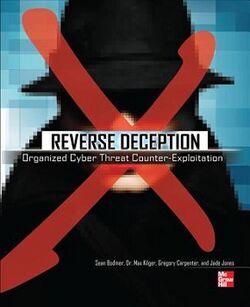Reverse Deception
 | |
| Author | Sean Bodmer Max Kilger Gregory Carpenter Jade Jones |
|---|---|
| Country | United States |
| Language | English |
| Genre | Cyber Security, Deception, Counter Deception, Threat Intelligence |
| Publisher | McGraw-Hill Publishers |
Publication date | 24 July 2012[1] |
| Media type | Paperback[2] |
| Pages | 464 pp[1] |
| ISBN | ISBN:978-0071772495 |
Reverse Deception: Organized Cyber Threat Counter-Exploitation is a book by Sean Bodmer, Max Kilger, Gregory Carpenter, and Jade Jones. It investigates methods and criteria to address organizational responses to Advanced Persistent Threats[3] and cyber deception.[4] It details how to identify APTs and prioritize actions by applying skilled, field-tested private and government sector processes and methods, which often involve cyber deception.[3]
Content
The book reviews the most historical and significant malware: Titan Rain, Moonlight Maze, Stakkato and Stuxnet are reviewed in light of APT criteria. The exploits of Stuxnet and these major cyber events are reviewed from an operational aspect. These exploits were so complex and expensive and that approaches an even less discussed concept: because the development of the APT is resource-intensive, it is most often believed to be sponsored by a government, in essence conducting an offensive action. In some countries, this can be a crime, while others consider it an aggressive defensive technique.
The work contains four stories regarding deception and counter deception. These are explained to be fictionalized works based on actual events that occurred somewhere in the law enforcement and intelligence worlds, but there is no way of vetting this, and it is not clear if these works are rooted in US domestic or international work. The cases are varied and considered compelling by[5] noted cybercritics and reviewers of this work.
The authors introduce the first theory for classifying a threat on the opportunistic-APT continuum as either persistent or non-persistent. The APT classifications and criteria are now widely used in the industry and are built off of an evaluation of the following criteria:[6][4][7]
APT CRITERIA[8]
- Objectives
- Timeliness
- Resources
- Risk tolerance (by the adversary)
- Skills and methods
- Actions
- Attack origination points
- Numbers involved in the attack
- Knowledge source
- Threat Intelligence
- Analysis of cyber espionage tactics contrasted with types of permissible countermeasures
- How to use deception and disinformation campaigns
- Case studies and real stories from the authors’ FBI, DOD, NSA, and private sector work.
- Value Chain Management
- Counter espionage and espionage
- Legal interpretations of capacities, limitations, and stipulations for assisting law enforcement investigations.[3]
Authors
- Sean M. Bodmer, CISSP, CEH, is founder and chief technologist at Pragmatik IO Group, INC.
- Dr Max Kilger, Ph.D., is specialist in profiling and behavioral analysis of the black hat community and hackers. He is a founding member of the Honeynet Project, is currently on their board of directors, and serves as their chief membership officer and chief profiler.
- Gregory Carpenter, DrPH, CISM, is an adjunct professor at Northern Virginia CC, on the International Board of Advisors at the Mackenzie Institute, Advisory Board at EC-Council University and on the board of directors of ATNA Systems.
- Jade Jones, Juris Doctor with experience including information operations and space law. He is a civilian with the Department of Defense and a Navy JAG Commander in the U.S. Naval Reserves.
See also
- Advanced Persistent Threat
- The Art of War
- Asymmetric Dominance
- Byzantine Foothold
- Carl von Clausewitz
- Computer Network Defense
- Computer network operations
- Cyberwarfare
- Deception
- Honeypot
- Information Warfare
- Moonlight Maze
- On War
- Operation Aurora
- Simulated Reality
- Solar Sunrise
- Stakkato
- Stuxnet
- Sun Tzu 孫子
- Titan Rain
References
- ↑ 1.0 1.1 "Reverse Deception Organized Cyber Threat Counter-Exploitation teaches you to debunk, pursue, and charge cyber attackers". http://www.barnesandnoble.com/w/reverse-deception-organized-cyber-threat-counter-exploitation-sean-bodmer/1118727859.
- ↑ "Identify, analyze, and block APTs". http://www.goodreads.com/book/show/13654753-reverse-deception.
- ↑ 3.0 3.1 3.2 "The intricate guide of detecting malicious code and decode the types of enemies they originate from". 12 July 2012. https://www.helpnetsecurity.com/2012/07/12/reverse-deception-organized-cyber-threat-counter-exploitation/.
- ↑ 4.0 4.1 "IEEE Book Reviews". https://www.ieee-security.org/Cipher/BookReviews/2013/Bodmer_by_austin.html. Retrieved 6 May 2019.
- ↑ "MrKoot Blog". https://blog.cyberwar.nl/2012/08/reading-notes-reverse-deception-organized-cyber-threat-counter-exploitation-bodmer-kilger-carpenter-and-jones-2012/.
- ↑ "Ben Rothke Slashdot". https://books.slashdot.org/story/12/11/12/1335222/book-review-reverse-deception. Retrieved 8 May 2019.
- ↑ "Matthijs R. Koot". http://www.infosecisland.com/blogview/22206-Reverse-Deception-Organized-Cyber-Threat-Counter-Exploitation.html. Retrieved 5 May 2019.
- ↑ "Reverse Deception". https://www.mheducation.com/highered/product/reverse-deception-organized-cyber-threat-counter-exploitation-bodmer-kilger/9780071772495.html.
External links
 |

